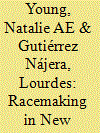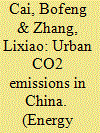| Srl | Item |
| 1 |
ID:
153230


|
|
|
|
|
| Summary/Abstract |
We explore how an ideologically diverse group of white students at Tulane University respond to evidence of racial inequality in post-Katrina New Orleans. In line with prior research, we find commonalities in racialized attitudes and behaviours between students whose racial ideologies otherwise differ. Drawing from anthropological theories of boundary construction and sociological work on colour-blind racism, we argue that the Otherization of non-whites is part of the everyday worldviews and social practices of white Americans. We draw on fieldwork in New Orleans to demonstrate that racist stereotypes and beliefs in racial difference continue to be transmitted within white social spaces. We find that even the most progressive Tulane students are engaged in the construction and reinforcement of symbolic and spatial boundaries between themselves and African Americans. This achieves the purpose for which racial stereotypes were originally constructed – namely, the persistence of racial inequality.
|
|
|
|
|
|
|
|
|
|
|
|
|
|
|
|
| 2 |
ID:
128033


|
|
|
|
|
| Publication |
2014.
|
| Summary/Abstract |
Different names/concepts and therefore different spatial boundaries for cities in China are responsible for the conflicting and confusing results associated with urban CO2 emissions accounting. In this study, four types of urban boundaries, i.e., city administrative boundary (UB1), city district boundary (UB2), city built-up area (UB3) and urban proper (UB4), were identified and defined. Tianjin was subsequently selected as the case city to illustrate the different performances of CO2 emissions with respect to these four boundaries using a 1-km grid dataset built bottom-up by point-emission sources. Different urban boundaries can induce a difference in CO2 emissions as large as 654%. UB1 and UB2 are not the appropriate proxies for urban boundaries in the analysis of urban CO2 emissions, although UB1 is a widely adopted boundary. UB3 is a good representative of city clusters and urban sprawl in a certain region, whereas UB4 is the appropriate system boundary for such issues as urban CO2 emissions in light of landscape characteristics and pertinent human activities, as well as the comparability to counterparts in developed countries. These results provide sound policy implications for the improvement of urban energy management and carbon emission abatement in China.
|
|
|
|
|
|
|
|
|
|
|
|
|
|
|
|